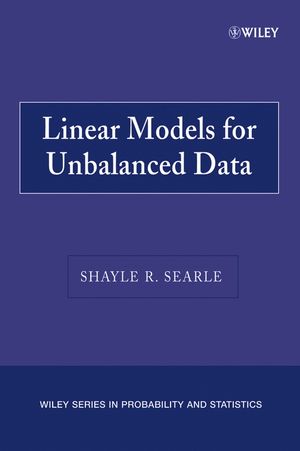Linear Models for Unbalanced DataISBN: 978-0-470-04004-1
Paperback
568 pages
March 2006
 This is a Print-on-Demand title. It will be printed specifically to fill your order. Please allow an additional 15-20 days delivery time. The book is not returnable.
|
||||||
WILEY-INTERSCIENCE PAPERBACK SERIES
The Wiley-Interscience Paperback Series consists of selected books that have been made more accessible to consumers in an effort to increase global appeal and general circulation. With these new unabridged softcover volumes, Wiley hopes to extend the lives of these works by making them available to future generations of statisticians, mathematicians, and scientists.
"[This book] provides an excellent discussion of the methodology and interpretation of linear models analysis of unbalanced data (data having unequal numbers of observations in the subclasses), generally without matrices?the author does an excellent job of emphasizing the more practical nature of the book. Highly recommended for graduate and undergraduate libraries."
â?"Choice
"This is a very comprehensive text, aimed at both students studying linear-model theory and practicing statisticians who require an understanding of the model-fitting procedures incorporated in statistical packages?This book should be considered as a text for college courses as it provides a clearly presented and thorough treatment of linear models. It will also be useful to any practicing statistician who has to analyze unbalanced data, perhaps arising from surveys, and wishes to understand the output from model-fitting procedures and the discrepancies in analysis from one recognized package to another."
â?"Biometrics
This newly available and affordably priced paperback version of Linear Models for Unbalanced Data offers a presentation of the fundamentals of linear statistical models unique in its total devotion to unbalanced data and its emphasis on the up-to-date cell means model approach to linear models for unbalanced data. Topic coverage includes cell means models, 1-way classification, nested classifications, 2-way classification with some-cells-empty data, models with covariables, matrix algebra and quadratic forms, linear model theory, and much more.
The Wiley-Interscience Paperback Series consists of selected books that have been made more accessible to consumers in an effort to increase global appeal and general circulation. With these new unabridged softcover volumes, Wiley hopes to extend the lives of these works by making them available to future generations of statisticians, mathematicians, and scientists.
"[This book] provides an excellent discussion of the methodology and interpretation of linear models analysis of unbalanced data (data having unequal numbers of observations in the subclasses), generally without matrices?the author does an excellent job of emphasizing the more practical nature of the book. Highly recommended for graduate and undergraduate libraries."
â?"Choice
"This is a very comprehensive text, aimed at both students studying linear-model theory and practicing statisticians who require an understanding of the model-fitting procedures incorporated in statistical packages?This book should be considered as a text for college courses as it provides a clearly presented and thorough treatment of linear models. It will also be useful to any practicing statistician who has to analyze unbalanced data, perhaps arising from surveys, and wishes to understand the output from model-fitting procedures and the discrepancies in analysis from one recognized package to another."
â?"Biometrics
This newly available and affordably priced paperback version of Linear Models for Unbalanced Data offers a presentation of the fundamentals of linear statistical models unique in its total devotion to unbalanced data and its emphasis on the up-to-date cell means model approach to linear models for unbalanced data. Topic coverage includes cell means models, 1-way classification, nested classifications, 2-way classification with some-cells-empty data, models with covariables, matrix algebra and quadratic forms, linear model theory, and much more.



